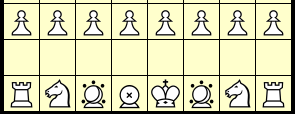[ List Earliest Comments Only For Pages | Games | Rated Pages | Rated Games | Subjects of Discussion ]
Comments/Ratings for a Single Item
 Mads Engelund wrote on Tue, Jun 10, 2003 01:30 PM UTC:Good ★★★★
Mads Engelund wrote on Tue, Jun 10, 2003 01:30 PM UTC:Good ★★★★The concept is very good, but it's actually a 5D game- 4 spatial and time. It needs to be simpler and the rook is too weak.
 Anonymous wrote on Sat, Aug 2, 2003 04:38 PM UTC:Excellent ★★★★★
Anonymous wrote on Sat, Aug 2, 2003 04:38 PM UTC:Excellent ★★★★★So what if it's 5D, at least it's not confusing. The idea behind the chits is simple and elegant. I had no headache like when I was reading Raumsnach. (Apology for my obvious misspelling of 'snach')
WOW. This was obviously well-thought-out and organized. Even though it deals with space-time in 5 dimensions, I wasn't confused at all. The author has managed to communicate a hugely complicated concept gracefully, using everyday language.
Though I don't much care for the zrf of this game (it's a 2 dimensional version, for those who don't know), I really, really like the concept and usage of the real thing. I admire this very much.
GREAT concept, a very good game, but it might be a better game with 'real' pieces, instead of the 'block' art.
 Ben Reiniger wrote on Tue, Aug 10, 2010 06:41 PM UTC:
Ben Reiniger wrote on Tue, Aug 10, 2010 06:41 PM UTC:I really like this concept, though I haven't played it before. Concerning the sample 'Case II', it is worth noting that even if U captures R--freeing B--W can immediately recapture B by the same move suggested. (It might be worthwhile to capture B now (as in the suggestion) just to threaten U's current square (if R is ever captured at his starting square, that is). Rooks do have the devastating ability to win the game in four moves (after two moves getting into position) by sweeping through the opponent's home row if they can avoid being captured first. While bishops enjoy greater mobility, their range is only half the board, so I think the pieces are relatively well balanced.
I have a question: Say it's someone's turn to move, but that person has no valid moves. What happens then? Do they lose? Stalemate? Or is that person's turn just skipped and the other person gets to go again?
7 comments displayed
Permalink to the exact comments currently displayed.
